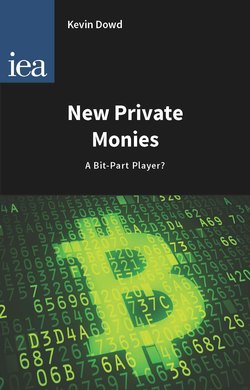Читать книгу New Private Monies - Kevin Dowd - Страница 7
На сайте Литреса книга снята с продажи.
Оглавление1 The Liberty DollarThe Liberty Dollar was designed by Bernard von NotHaus, the founder of the National Organization for the Repeal of the Federal Reserve and the Internal Revenue Code (NORFED). It was launched on 1 October 1998. At its inception, von NotHaus announced that his objective was to ‘be to the Federal Reserve System what Federal Express was to the Post Office’ by providing a private voluntary barter currency as an alternative to Federal Reserve currency. The new Liberty Dollar was to be based primarily on gold and silver coinage – though strictly speaking they should be described in law as ‘medallions’5 – and its precious metallic basis was to provide protection against the inflation to which the inconvertible dollar has been prone since World War II, thanks to the Federal Reserve’s predilection for expansionist monetary policies.The Liberty Dollar consists primarily of coins in gold and silver; a second component consisted of warehouse receipts redeemable on demand in specie stored securely in an audited warehouse in Idaho; and a third component, the ‘eLibertyDollar’, consisted of digital warehouse receipts.6 Thus, the Liberty Dollar existed in specie, paper and digital form, and all forms of the Liberty Dollar were denominated in units of Liberty Dollars.
5 In private correspondence, Mr von NotHaus informs me that the Liberty Dollar organisation was always extremely careful never to refer to any of its specie pieces as a coin because issuing coins for monetary purposes in the US would have been in violation of 18 USC §486, which states:
Whoever, except as authorized by law, makes or utters or passes, or attempts to utter or pass, any coins of gold or silver or other metal, or alloys of metals, intended for use as current money, whether in the resemblance of coins of the United States or of foreign countries, or of original design, shall be fined under this title or imprisoned not more than five years, or both.
I shall therefore use his terminology for reasons of legal precision, but readers are free to interpret the terms ‘coin’ and ‘medallion’ interchangeably if they wish.
6 The digital version of the Liberty Dollar was launched in November 2002 and users could email digital Liberty Dollars to each other or use them in online trade. The system was highly secure, audited monthly and charges were very low (zero for transactions under $10 and 37 cents for other transactions) and much lower than was being charged, for example, by Visa or Mastercard. This system was highly successful and a large amount of the Liberty Dollar gold and silver that was eventually confiscated by the government in 2009 backed the digital warehouse receipts.
